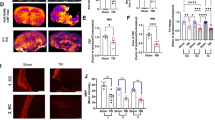Abstract
Pirh2, a p53-induced ubiquitin-protein ligase, has been reported to promote ubiquitin-dependent degradation of p27kip1, which plays an essential role in mammalian cell cycle regulation and neurogenesis in the developing central nervous system (CNS). However, their distributions and functions in the nervous system lesion and repair remain unclear. In this study, we observed that the up-regulated expression of Pirh2 was concomitant with decreased p27kip1 level after traumatic brain injury by Western blot and immunohistochemistry. Immunofluorescence double-labeling revealed that Pirh2 was mainly co-expressed with GFAP and CD11b. Meanwhile, we also examined the expression profiles of proliferating cell nuclear antigen (PCNA) whose changes were correlated with the expression of Pirh2. In addition, Pirh2 colocalized with p27kip1 and PCNA. Immunoprecipitation further showed that they interacted with each other in the pathophysiology process. In summary, our data indicated Pirh2 might be a negative regulator of p27kip1 and associated with glial proliferation.





Similar content being viewed by others
References
Beitel LK, Elhaji YA, Lumbroso R et al (2002) Cloning and characterization of an androgen receptor N-terminal-interacting protein with ubiquitin-protein ligase activity. J Mol Endocrinol 29:41–60
Bloom J, Pagano M (2003) Deregulated degradation of the cdk inhibitor p27 and malignant transformation. Semin Cancer Biol 13:41–47
Busch SA, Silver J (2007) The role of extracellular matrix in CNS regeneration. Curr Opin Neurobiol 17:120–127
Carrano AC, Eytan E, Hershko A (1999) SKP2 is required for ubiquitin-mediated degradation of the CDK inhibitor p27. Nat Cell Biol 1:193–199
Carruthers S, Mason J, Papalopulu N et al (2003) Depletion of the cell-cycle inhibitor p27 (kip1) impairs neuronal differentiation and increases the number of ElrC (+) progenitor cells in Xenopus tropicalis. Mech Dev 120:607–616
Catzavelos C, Bhattacharya N, Ung YC et al (1997) Decreased levels of the cell-cycle inhibitor p27Kip1 protein: prognostic implications in primary breast cancer. Nat Med 3:227–230
Chen Q, Xie W, Kuhn DJ et al (2008) Targeting the p27 E3 ligase SCF(Skp2) results in p27- and Skp2-mediated cell-cycle arrest and activation of autophagy. Blood 111:4690–4699
Chiariello M, Gomez E, Gutkind JS (2000) Regulation of cyclin-dependent kinase (Cdk) 2 Thr-160 phosphorylation and activity by mitogen-activated protein kinase in late G1 phase. Biochem J 349(Pt 3):869–876
Doetsch F, Verdugo JM, Caille I et al (2002) Lack of the cell-cycle inhibitor p27Kip1 results in selective increase of transit-amplifying cells for adult neurogenesis. J Neurosci 22:2255–2264
Fillies T, Woltering M, Brandt B et al (2007) Cell cycle regulating proteins p21 and p27 in prognosis of oral squamous cell carcinomas. Oncol Rep 17:355–359
Hattori T, Isobe T, Abe K et al (2007) Pirh2 promotes ubiquitin-dependent degradation of the cyclin-dependent kinase inhibitor p27Kip1. Cancer Res 67:10789–10795
Kamura T, Hara T, Matsumoto M (2004) Cytoplasmic ubiquitin ligase KPC regulates proteolysis of p27(Kip1) at G1 phase. Nat Cell Biol 6:1229–1235
Kipreos ET, Pagano M (2000) The F-box protein family. Genome Biol 1:REVIEWS3002
Königsmark BW (1970) Methods for counting of neurons, in: Contemporary Research Methods in Neuroanatomy. W.J.H. Nauta, and S.O.E. Ebbesson (eds), Springer: New York, pps: 315–340.
Langlois JA, Rutland-Brown W, Wald MM (2006) The epidemiology and impact of traumatic brain injury: a brief overview. J Head Trauma Rehabil 21:375–378
Leng RP, Lin Y, Ma W et al (2003) Pirh2, a p53-induced ubiquitin-protein ligase, promotes p53 degradation. Cell 112:779–791
Liu Y, Wang Y, Cheng C et al (2010) A relationship between p27 (kip1) and Skp2 after adult brain injury: implications for glial proliferation. J Neurotrauma 27:361–371
Logan A, Frautschy SA, Gonzalez AM et al (1992) A time course for the focal elevation of synthesis of basic fibroblast growth factor and one of its high-affinity receptors (flg) following a localized cortical brain injury. J Neurosci 12:3828–3837
McGraw J, Hiebert GW, Steeves JD (2001) Modulating astrogliosis after neurotrauma. J Neurosci Res 63:109–115
Miyazawa K, Himi T, Garcia V et al (2000) A role for p27Kip1 in the control of cerebellar granule cell precursor proliferation. J Neurosci 20:5756–5763
Nguyen L, Besson A, Roberts JM et al (2006) Coupling cell cycle exit, neuronal differentiation and migration in cortical neurogenesis. Cell Cycle 5:2314–2318
Nieto-Sampedro M (1999) Neurite outgrowth inhibitors in gliotic tissue. Adv Exp Med Biol 468:207–224
Raghupathi R (2004) Cell death mechanisms following traumatic brain injury. Brain Pathol 14:215–222
Ridet JL, Malhotra SK, Privat A et al (1997) Reactive astrocytes: cellular and molecular cues to biological function. Trends Neurosci 20:570–577
Sgambato A, Cittadini A, Faraglia B et al (2000) Multiple functions of p27 (Kip1) and its alterations in tumor cells: a review. J Cell Physiol 183:18–27
Sheaff RJ, Groudine M, Gordon M et al (1997) Cyclin E-CDK2 is a regulator of p27Kip1. Genes Dev 11:1464–1478
Shen AG, Shi SX, Chen ML et al (2008) Dynamic changes of p27 (kip1) and Skp2 expression in injured rat sciatic nerve. Cell Mol Neurobiol 28:713–725
Sheng Y, Laister RC, Lemak A et al (2008) Molecular basis of Pirh2-mediated p53 ubiquitylation. Nat Struct Mol Biol 15:1334–1342
Slingerland J, Pagano M (2000) Regulation of the cdk inhibitor p27 and its deregulation in cancer. J Cell Physiol 183:10–17
Spruck C, Strohmaier H, Watson M (2001) A CDK-independent function of mammalian Cks1: targeting of SCF (Skp2) to the CDK inhibitor p27Kip1. Mol Cell 7:639–650
Vlach J, Hennecke S, Amati B (1997) Phosphorylation-dependent degradation of the cyclin-dependent kinase inhibitor p27. EMBO J 16:5334–5344
Author information
Authors and Affiliations
Corresponding authors
Additional information
X. Wu and W. Shi contributed equally to this work.
Rights and permissions
About this article
Cite this article
Wu, X., Shi, W., Zhao, W. et al. Changes in Pirh2 and p27kip1 Expression Following Traumatic Brain Injury in Adult Rats. J Mol Neurosci 46, 184–191 (2012). https://doi.org/10.1007/s12031-011-9572-9
Received:
Accepted:
Published:
Issue Date:
DOI: https://doi.org/10.1007/s12031-011-9572-9




